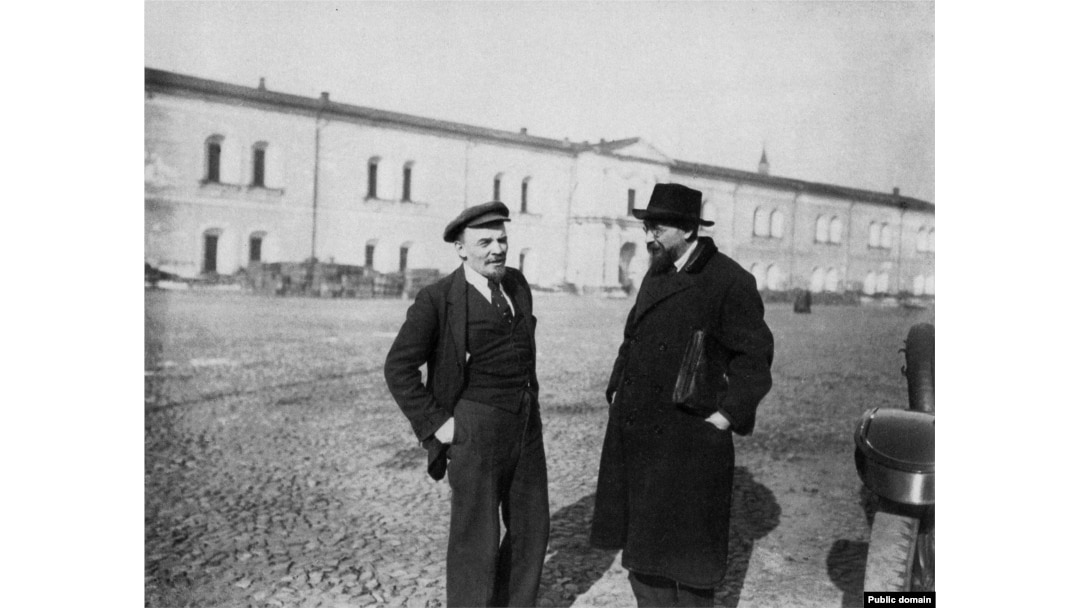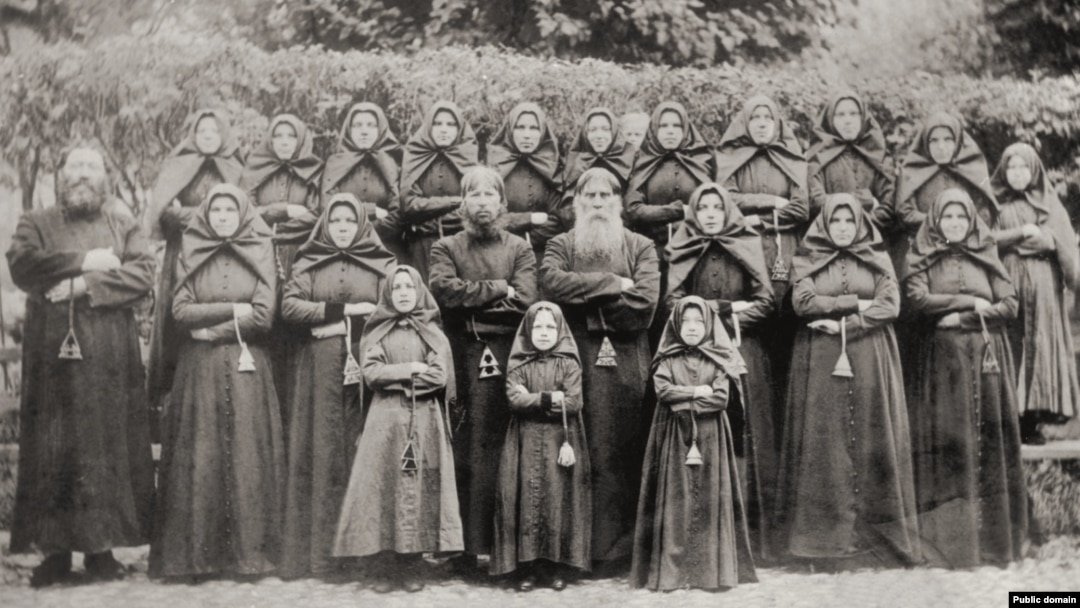At a meeting in Soviet Russia's Krasnoyarsk territory in 1930, residents of Solona Village listened to state functionaries espousing what they claimed were the advantages of collective farms.
No one dared to object until one Manchenko, an Evangelical Christian, took the floor. Villagers should not rush to join the collective farms, Manchenko told the crowd, because a far more tempting prospect lay ahead in the fledgling Soviet Union. "For we Baptist Christians a new city, a city of the sun will be built in the center of Siberia where only Baptists will live and build our own industries. It will be ideal for us."
A secret policeman at the meeting noted down Manchenko's words. The project the Baptist speaker had mentioned had very nearly come to pass but, unbeknown to Manchenko and other Evangelical Christians, it had recently been shot down by Josef Stalin.

Vladimir Lenin and Vladimir Bonch-Bruevich in 1918
In the 1920s a great city in Siberia that was to be called "Evangelsk" was envisioned by Ivan Prokhanov.
Prokhanov was an Evangelical Christan leader who founded the All-Russian Union of Evangelical Christians in 1908 and then led the religious organization. When the Bolsheviks swept to power in 1917, Prokhanov stayed quiet about Russia's militant atheist rulers, apparently to leave room for potential cooperation.
The religious leader believed Siberia could become, "a land on which Evangelical Christians would create a new, better life for the Russian people and turn it into the most advanced and developed part of the continent."
Many among Russia's religious groups outside the Russian Orthodox Church had initially welcomed the establishment of Soviet power in Russia, in part because of the appeal of communal living among some sects.
In 1919 a leader of the Tolstoyans, a Christian movement influenced by the philosophy of Russian author Leo Tolstoy, told a meeting of Soviet revolutionaries, "We wish to cooperate with you in the cause of building communism.” He then asked that the religious sect not be reproached for "heading toward communism by a different path."
Dukhobors in Canada in the early 1900s. Thousands of members of the religious sect had fled persecution in tsarist Russia and settled in Canada.
In 1920, Tolstoyan leadership drafted a document claiming they knew how to overcome the reluctance of Russia's peasantry to commit to the "new communist principles." The answer, they claimed, was to attract Christian sectarians who were the most "conscious and rationally religious set of the Russian people."
If permitted by the Soviet authorities, "the 6 or 10 million-strong mass of Russian sectarians scattered throughout Russia, Ukraine, the Caucasus and Siberia" would give the peasants an example of how life under communism could work, the authors claimed.
The document was handed to Vladimir Bonch-Bruevich, an expert on the history of Christian sects who also happened to be Vladimir Lenin's personal secretary. Bonch-Bruevich believed that Evangelical Christians, Baptists, Dukhobors, Old Believers, Jehovah's Witnesses, Enochians, Tolstoyans, Dobrolyubovites, and all other sect members would be willing partners in building Russian communism. He was able to put this belief to the test.
In 1920, Bonch-Bruyevich organized the Lesnye Polyany state farm near Moscow, convincing members of several religious sects, including pacifist Dukhobors who had fled oppression in tsarist Russia, largely to Canada, to join a collective farm.
Lenin took a personal interest in how the experiment was going.
The destruction of the Cathedral of Christ the Savior in December 1931 amid anti-religious repression throughout the Soviet Union
In a letter Lenin wrote to Bonch-Bruevich in August 1921, the Soviet leader asked:
"Is it true that you took the Dukhobors to the state farm and that you're very pleased with them? 2) How are things going with the transportation of the Dukhobors (a) from Canada, (b) from the Caucasus to Russia?"
Bonch-Bruevich responded, writing, "Dear Vladimir Ilyich! That's right, they came to the state farm with the greatest joy and pleasure," he claimed. "Almost everything is communal, from the canteen and the children's dormitory to the common wardrobe and linen. Of course there is a common cash register, etc. They work amazingly well. They do not require any prodding, but only always ask to precisely define the task."
The Lesnye Polyany farm, which supplied goods to the Soviet elite, was a success and in 1921 the Soviet mouthpiece Izvestia published an appeal "to sectarians and Old Believers living in Russia and abroad" to join collective farms. The state promised "not to interfere in religious affairs" of the settlements.
What followed was dubbed "the golden age of sectarianism" in which followers of various Christian movements received plots of land and created their own agricultural communes throughout Soviet Russia.
The idea then emerged of creating an entire city of various Christian denominations who would work and live together in the wilderness of the Soviet Union.
Prokhanov, the author of the idea of the City of the Sun
Prokhanov had firsthand experience of Christian communes. In 1894 he was one of the founders of one in Crimea called Vertograd. Prokhanov held fond memories of the religious settlement.
"After a hard day's work we gathered together for dinner. I read from church history, the sisters sewed and mended," he recalled of the commune. "These were unforgettable evenings. We were very happy in our Vertograd."
But the religious village was shut down by Russia's tsarist authorities four years after opening.
With the Bolsheviks in power, Prokhanov watched closely as religious communes sprang up. The success of some of these initiatives gave Prokhanov the idea for an entire city, in which, in his utopian vision, electricity would reduce the need for hard physical labor, and no one would cheat, drink, or smoke.
"Even in poor houses there is to be exemplary order, the rooms will be tidy and all things in their place. The children will be properly dressed, the hostess has her hair done and will look welcoming," he wrote of the imagined city.
Along with a screed that noted how many times inhabitants of the fantasy city should clean themselves and brush their children's hair, Prokhanov imagined a "bright electric 'sun'" that would shine over the center of the settlement.
"The Gospel settlement must shine like a bright beacon in the distant surroundings and call other villages to transform and renew their lives."
Much of the utopian dream seems obviously untenable, including the giant electric 'sun' that would make sleep difficult for the city's inhabitants after long daylight hours of work. But the Soviet government recognized in Prokhanov, with his fastidious details on dictating how life needed to be lived, an ideological fellow traveler.
Evgeny Tuchkov
Remarkably, the idea for a Christian city was supported by the Soviet authorities, including Yevgeny Tuchkov, one of the most ruthless of Lenin's henchmen, whose role was to stamp out Orthodox Christianity within the Soviet Union. Tuchkov was behind the arrest and execution of several Orthodox clergymen.
It is hard to determine what lay behind Tuchkov's support for the building of a religious city in Siberia. Some have speculated that it stemmed from the desire to get followers of Christian sects out of the cities and villages throughout the Soviet Union where their ideas could spread. If condensed into one place the Christian groupings could be closely watched and easily controlled if the state required.
Tuchkov was directly involved in the planning of the new city and helped get permission from Kremlin bureaucrats for an expedition to Soviet Russia's Altai region in order to choose a location for the "city of believers."
The site the expedition settled on was a deserted shore at the confluence of the Biya and Katun rivers. The expedition leaders planted North American maple and Siberian cedar seedlings to symbolize the unification of believers from two continents, then gave speeches heralding a bright future for this obscure patch of land.
Prokhanov with his companions after the symbolic planting of seedlings
Neither Prokhanov nor his companions knew why such a beautiful place was uninhabited. Before the Bolsheviks seized power, Russian Old Believers lived here. They had transformed the area into a prosperous farm but were exterminated after rebelling against the Bolsheviks during Russia's civil war. The cedar and maple trees were placed nearly on the graves of the former inhabitants of the land.
All appeared to be on track for the religious settlement to begin construction, but in May 1928 the project reached the ears of Josef Stalin, the new ruler of the Soviet Union. The Georgian was incensed by the "outrageous fact" that Soviet bureaucrats had allowed the planning of a religious city to reach an advanced stage.
Soviet leadership requested that Yemelyan Yaroslavsky, the head of the Union of Militant Atheists, look into the plans for a religious city. The anti-Christian crusader saw religious sects as "a complex and powerful apparatus of agitation and propaganda." Christians, he said, were "building their nests everywhere."
After Yaroslavsky filed a critical report on the city-building initiative, the Kremlin decided to "liquidate the case of the All-Union Council of Evangelical Christians organizing the city of Evangelsk in Siberia."
The destruction of the Cathedral of Christ the Savior in December 1931 amid anti-religious repression throughout the Soviet Union
The move marked a turn toward direct and open repression of Christian sects in the Soviet Union. Religious communes began to be "exposed" in the press with stories that claimed the groups "mercilessly exploit the poor," and several were shut down by the authorities.
Amid the increasing hostility toward religious groups, Prokhanov left the Soviet Union for the United States and chose not to return.
The man who envisioned a homeland for Evangelical Christians in the Soviet Union spent the final part of his life as a wanderer. He died in Berlin in 1936.


